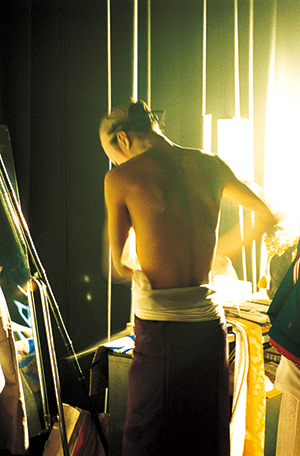 In stark contrast to the stifling heat and humidity outside the studio under the glare of Tokyo Tower, the dark, cavernous room, in the middle of which sits an elaborate set with cherry trees in full bloom, is chilly and abuzz with activity, with half a dozen cameras being tested and re-tested, directors barking orders to assistants and lighting crews giving the elevated platform a hazy blue glow before switching to blinding pink.
In stark contrast to the stifling heat and humidity outside the studio under the glare of Tokyo Tower, the dark, cavernous room, in the middle of which sits an elaborate set with cherry trees in full bloom, is chilly and abuzz with activity, with half a dozen cameras being tested and re-tested, directors barking orders to assistants and lighting crews giving the elevated platform a hazy blue glow before switching to blinding pink.
“Enjoy the show,” chimes the manager, who has given us “front row” seats amid intertwining cables and myriad of boxes containing film reel and recording paraphernalia. The occasion is Taichi Saotome’s recording of a DVD collection of dances that will last until near midnight on a Sunday night – heavy duty work for a 15-year-old, albeit one that has worked and lived in the limelight long enough to have matured well beyond his age.
Taichi Saotome may best be remembered by Western audiences as the kimono-clad youth who crashes into the windshield of a taxi in the surreal 2005 movie Takeshis’, directed by the critically acclaimed Takeshi Kitano. Much as he does today, Saotome showed his two “faces” in that motion picture nominated for the Golden Lion Award at the Venice Film Festival. One was his unaltered look – that of a plain, boyish figure dressed in a red sweatshirt and clutching a soccer ball. The other, which has led his fame to skyrocket, sending hundreds of fans to sold-out performances, was his female impersonation, or onnagata, where he appeared made up and robed immaculately as a geisha, his soft facial features, thin eyes and slight frame allowing a delicate, truly feminine expression to emanate from his body and especially his bone-white face, blood red lips and extended eyelashes painted coal black.
With preparations nearing completion, Saotome makes a quiet entrance, closely followed by a make-up artist and a choreographer, both of whom will monitor his every move while on stage. Shrouded in a dark silk kimono and exuding a feminine pallor as never before, his look and his movements, seen live, are enthralling. “Isn’t he beautiful,” interjects the manager, who makes sure that a bottle of Saotome’s favorite drink, Calpis, is readily available nearby, along with a straw so as not to disfigure the young actor’s immaculate make-up.
Saotome makes his pre-acting arrangements with a professional calmness, quietly nodding to instructions, and occasionally going through the motions – a quick turn of the wrist or movement of the upper body – to ensure he has it right. Final calls confirming set-up arrangements are exchanged on the floor. Everything is a go. Saotome gently climbs the stairs of the platform, his kimono allowing only short, dainty steps and makes his way behind the faux cherry trees.
Take one. The music, a neo-traditional piece called “Yozakura Oshichi,” begins playing and Saotome emerges from in between the pink petals, partially obscuring his face with a burgundy Japanese fan. It’s a melancholic song, in line with the ephemeral theme of cherry blossoms, about parting with a lover, delivered in the trademark high-pitched and emotional tones of singer Fuyumi Sakamoto. Saotome, now transformed into the female embodiment of those lyrics, glides across the platform making twists and turns with arms outstretched, exhibiting the full glamour of his kimono. His short, quick steps take him forward, backward and sideways with great ease, almost defying the restricted movement of the lower body that defines feminine beauty.
The piece progresses with a crescendo and an explosion of glittering confetti rains down on the stage. Saotome snaps open a second fan, identical to the first, and deftly manipulates them in tandem, gyrating and swiveling the pair, knocking one into the air with the other and catching it in mid-spin, all timed to precision with the score. The lyrics, meanwhile, recite the sorrow of knowing that a lover has gone and will not return, he being as good as dead. All that remains is a blizzard of cherry blossoms, and Saotome, in his final steps, retreats, with one fan clutched in his pale, wavering hand and the other partially masking his face, just as it had done in the beginning, symbolic of introspectiveness. His expression is the epitome of lament, his eyes looking down, forlornly at the camera. Cut.
“I can’t completely adopt the feelings of a woman,” Saotome later says, in between takes. “I believe that men and women probably think and feel in slightly different ways, but I also think their emotions aren’t so different. Like melancholy, for example, that doesn’t really change (whether you’re a man or a woman). So while I can’t completely turn into a woman, when I have to play a tragic role, I immerse myself in those sad feelings and play the act.”
To the layperson’s eye, it’s more than convincing, and observing that first take alone is quite sufficient to perceive that Saotome is indeed extraordinarily gifted in the art of onnagata. But art requires perfection and it requires four more takes on this day for the choreographer to sign off with her blessing.
After each take, Saotome never wavers in his concentration, repeating the motions, especially those involving the dexterous handling of the fans, and viewing the recording of the previous take, making mental calculations of the steps and movements. While many performers are known to unwind off set, Saotome feels differently. “Since I’m always performing in front of the audience, I’m not really used to the atmosphere of dancing when there is nobody around,” he says. “Like today. It’s not nervousness, but I feel much more at ease with the audience there. Those who do a lot of television work say they find it difficult when people are watching, so it’s the opposite for me. It’s like becoming one with the crowd.”
Born into an acting family (his father, Yonosuke Aoi, is the zacho, or “king,” of the taishu engeki troupe Gekidan Sujyaku), Saotome began learning the dance at four years of age, although the art of mastering expression did not come until much later. Unlike kabuki, the centuries-old entertainment for the elite, where acting is done exclusively by men, taishu engeki, loosely translated as “stage for the masses,” are performances commonly undertaken by traveling troupes that reflect this “public” nature and are often held on stages much closer to the audience, and, in many cases, are much more affordable.
Another characteristic of this vaudevillian art, which only came to existence in the 20th century, is that actors are often interrupted in mid-performance to be showered with gifts and allowances by the crowd.
Given such a background, it is no wonder that Saotome feels most at home on stage, but it was in fact a part in Takeshi Kitano’s 2003 award-winning epic Zatoichi that led him to build and refine his expressive acting.
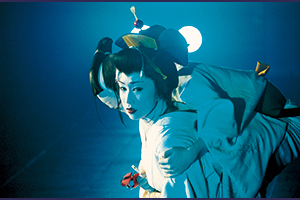 In Zatoichi, Saotome played the young Osei, turning in a remarkable performance in scenes where he witnesses the murder of his family, and, later, struggles with orphanhood alongside his sister.
In Zatoichi, Saotome played the young Osei, turning in a remarkable performance in scenes where he witnesses the murder of his family, and, later, struggles with orphanhood alongside his sister.
Of his experience working on his first movie set, Saotome says, “When I did Zatoichi, I was 10 and wasn’t thinking too much. Up until that point, I had only acted on stage, where (action) is continuous from the beginning until the end. In film, it’s all done in pieces, all the scenes are taken independently and it requires you to act in a certain way, then switch abruptly to a completely different mood. It’s difficult, and that has been a really good experience.”
On Kitano, the director, Saotome adds: “Takeshi kantoku (director) fundamentally doesn’t really give advice. He has the actor bring out his or her own individuality. He did teach me the small things, though.”
Indeed, film taught Saotome something small in actual terms, but something quintessentially important for his trade. “The thing I most learned was facial expression,” he says. “On stage, the audience is at a distance, but in film, the camera comes right up close, so I was taught that even the eyes have to act – that was the most memorable thing.”
Five years on, Saotome has undergone extensive training in expression, refining his dance and portraying onnagata, and his performance today is a testament to the diligence with which he has undertaken his profession. His gaze is as emphatic as his dance, penetrating the audience and telling a story all by itself. The eyes, though, are sometimes a problematic issue for Saotome.
“They change,” he says. “Depending on how much sleep I’ve had, sometimes my eyelids fold, even double fold, so I have to change the eye-line. Depending on the day, my look could be different.” Saotome, who does his own make-up, grapples with the hardships of facial presentation even prior to delivering the performances – an art in itself, some might say.
This too, though, he has accomplished to perfection, and building on his performances over the years Saotome has amassed an army of enthusiastic fans, from television celebrities he has met on shows to die-hard followers of traditional Japanese stage. But Saotome has made a recent, pleasant discovery that could propel him onto the world stage in the years to come – that language is no barrier to the true forms of expression and acting. On his first overseas performance tour to Hawaii earlier this year, he found a reception quite unlike what he expected.
“When I first saw the crowd, there were a lot of Asian faces, so it didn’t seem very different,” he recalls. “But once we were actually performing the reaction was very different from that in Japan. People were really showing their emotions. Since our languages were different, I wasn’t sure whether the message would go across, but there were quite a few people that were crying. The music, our movements and our expressions carried the message, and that made me really happy.”
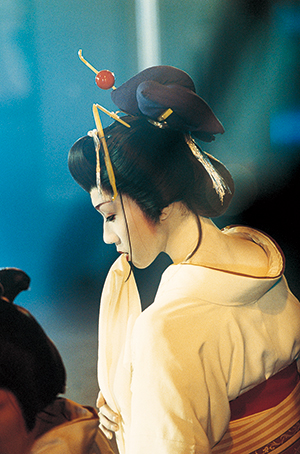 One of his gripes about the tour, however, was that Saotome could not interact with his audience, owing to his lack of knowledge of the English language.
One of his gripes about the tour, however, was that Saotome could not interact with his audience, owing to his lack of knowledge of the English language.
“That made me really frustrated,” he says, “but I’d like to go abroad more. Perhaps France.”
During the brief interval in which Saotome disrobes, showers and prepares for his next performance, the interior of the studio also transforms into a pitch black setting, where four candles emit the only visible, eerie glow that barely reveals the outline of an ivory Japanese katana (sword) lying on the floor. The temperature is now brought down much lower – the manager tells us that Saotome will be exerting himself considerably more for this dance – to the point where the heat outside the studio is somewhat nostalgic.
“From now on, I won’t only be playing onnagata roles. I’m quite fond of tate – dancing with a katana – so I had the choreographer make a kenbu part for me,” Saotome had confided during the break, sharing his hopes to challenge various genres of performance, including tap dancing, one of his hobbies. This, therefore, would be a tate performance and, again, Saotome makes a quiet appearance, this time dressed in a dove-white hakama, his natural, boyish face now back to a rosy pink shade. He takes his position lying cross-legged with arms outstretched and keeled over as if in prayer, and then launches into the motions, this one an authoritative, manly dance.
The moves are as precise as clockwork, and spellbinding. “If you slack off in your everyday routines, the audience can see right through you,” Saotome claims. “I don’t lead a perfect life now, but I try to be as strict and formal as I can.”
The 15 year-old claims that a stern upbringing be his father has led him to hold dear such val-young man for delivering every performance from deep within.
Story by Seiji Komachi
From J SELECT Magazine, September 2007

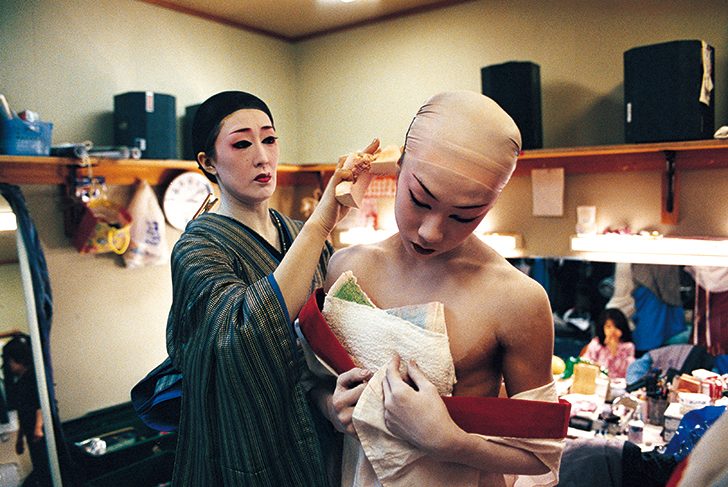


-150x150.jpg)
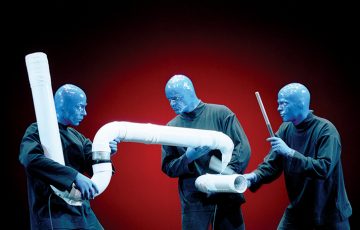


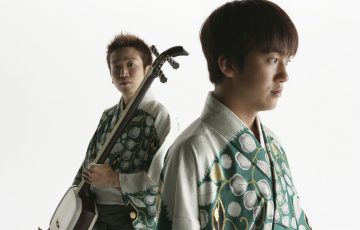


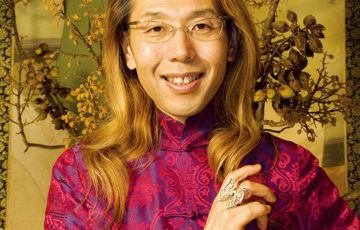



Recent Comments